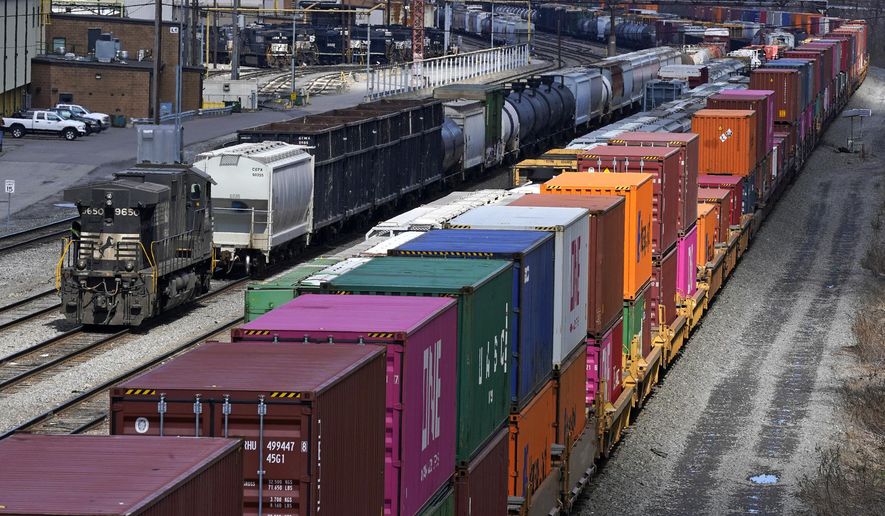President Biden is under pressure to resolve a labor dispute that threatens to disrupt freight rail lines and the nation’s supply chain just weeks before the November elections.
He plans to appoint a team of arbitrators to a presidential emergency board as early as Monday to negotiate a settlement between the rail companies and 12 labor unions that have been unable to reach a deal on pay, benefits and working conditions after two years of negotiating.
Rail workers and labor activists are now counting on the White House to appoint an arbitration board that supports their contract demands and upholds Mr. Biden’s pledge to be “the most pro-union president leading the most pro-union administration in American history.”
Rail companies have rejected many of the union demands for higher pay, better benefits and work reforms. If Mr. Biden’s arbitration team cannot break the impasse, up to 115,000 rail workers are poised to strike in mid-September, just weeks before the Nov. 8 elections.
A rail strike would cause significant disruptions in the nation’s pandemic-addled supply chain and would be politically disastrous for Mr. Biden, who already has low approval ratings from voters who blame him and congressional Democrats for high inflation and gasoline prices.
“The U.S. business community faces enormous challenges today from record inflation, labor shortages, and ongoing supply chain disruptions due to the COVID-19 pandemic,” Chamber of Commerce CEO Suzanne Clark warned in a recent letter urging Mr. Biden to resolve the rail dispute. “Any breakdown would be disastrous for U.S. consumers and the economy, and potentially return us to the historic supply chain challenges during the depths of the pandemic.”
SEE ALSO: Biden leaves Saudi Arabia without oil deal amid criticism for meeting with crown prince
Rail worker unions, citing record-high inflation, are seeking a pay increase of 47% over five years, the publication Railway Age reported.
People connected to the negotiations told The Washington Times that details of the demands are generally kept secret but that workers are also seeking more predictable hours and the elimination of a plan to cut manpower on some trains from two train operators to one, a proposal that “terrifies” workers.
Rail employees also complain of long hours, too few days off and being paired with workers with no experience or training.
Rail companies say the workers’ pay demands are too steep and that inflation will eventually decrease. The companies say they are losing money as a result of trucking industry competition and hauling fewer loads of coal.
The Biden administration will have to negotiate the gaping divide to avoid a strike, and unions and labor activists are watching closely.
Democrats are eager to hold on to the backing of union workers as Republicans tailor their agenda more to the working class and lure away support from rank-and-file union members.
Mr. Biden has led the effort to bolster Democrats’ union ties. He has invited union leaders to the White House, promised to expand organized labor and signed an executive order in April 2021 establishing a White House task force on worker organizing and empowerment. He put Vice President Kamala Harris in charge of the task force.
“Biden has a huge opportunity here to show his solidarity to the unions and with the railroad workers,” Paula Pecorella, who follows the rail labor dispute for More Perfect Union, a labor movement and corporate accountability website. “And one of the ways that he can absolutely do that is by appointing a presidential emergency board that has members who will really take into consideration the life-threatening conditions that railroad workers in the United States are facing right now, and will appoint people who are friendly and sympathetic to those issues and who will offer them a fair contract.”
The board will have 30 days to hear from both sides and another 30 days for the rail worker unions and the rail companies to consider recommendations from the arbitration board.
“If they haven’t reached a contract, workers are allowed to go on strike,” Ms. Pecorella said.
The last railway strike, in 1992, lasted two days under President George H.W. Bush. The Bush White House said the crippling strike cost $1 billion per day in lost wages and production. It ended when Congress intervened with a bill prohibiting strikes and lockouts and establishing a last-ditch arbitration system to settle the dispute.
One of the 12 unions involved in the current labor dispute, the Brotherhood of Locomotive Engineers and Trainmen, made up of more than 57,000 locomotive engineers, conductors, brake operators and firefighters, voted last week to authorize a strike. Other unions are likely to follow absent a deal.
Rail carriers, BLET union officials said, have “stonewalled” at the bargaining table.
“In the end, the question of whether or not any of the rail industry’s union-represented employees want to legally strike is secondary to what they truly want,” BLET National President Dennis R. Pierce said in a statement. “They want a contract with meaningful wage increases and good benefits. They want jobs that give them the ability to have a life outside of work.”
• Susan Ferrechio can be reached at sferrechio@washingtontimes.com.




Please read our comment policy before commenting.